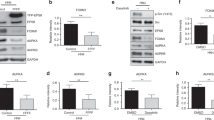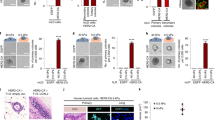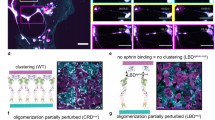Abstract
The oncogenic tyrosine kinase Src has a role in cancer development, especially by promoting invasive and metastatic behavior. It is, however, unclear which of the Src-regulated signaling cascades induce malignant phenotype in three-dimensional environment. One of Src substrates is ezrin, a cytoskeletal organiser and regulator of signal transduction. Ezrin expression correlates with poor outcome of diverse cancers and is essential in experimental metastatic osteosarcoma. We reconstituted genetically ezrin-deficient cells with wild-type (WT) or phosphorylation-deficient Y477F ezrin together with constitutively active Src. In two-dimensional cultures, Src induced malignant features regardless of the presence or absence of ezrin. In contrast, only WT ezrin-expressing cells grew efficiently in soft agar or in suspension. In Matrigel, only WT ezrin significantly promoted growth and invasion, and was targeted to specific regions on the plasma membrane. WT and Y477F ezrin-expressing cells showed marked differences only when growing or scattering in three-dimensional matrix. Additional experiments showed that Y477-phosphorylated ezrin is also needed for the growth of Src-transformed epithelial cells in three-dimensional matrix. Cells lacking functional ezrin had reduced cyclin D levels and fewer cells in G2+S phase, possibly as a consequence of abnormal mTOR signaling, as ezrin Y477F cells showed lower expression of phosphorylated intermediates downstream of mTOR than WT cells. We conclude that the pathways activated by Src depend on the type of environment and that ezrin is a crucial element of Src-induced malignant features in cells growing inside three-dimensional environment.
This is a preview of subscription content, access via your institution
Access options
Subscribe to this journal
Receive 50 print issues and online access
$259.00 per year
only $5.18 per issue
Buy this article
- Purchase on Springer Link
- Instant access to full article PDF
Prices may be subject to local taxes which are calculated during checkout







Similar content being viewed by others
References
Alfthan K, Heiska L, Gronholm M, Renkema GH, Carpen O . (2004). Cyclic AMP-dependent protein kinase phosphorylates merlin at serine 518 independently of p21-activated kinase and promotes merlin-ezrin heterodimerization. J Biol Chem 279: 18559–18566.
Aligayer H, Boyd DD, Heiss MM, Abdalla EK, Curley SA, Gallick GE . (2002). Activation of Src kinase in primary colorectal carcinoma: an indicator of poor clinical prognosis. Cancer 94: 344–351.
Autero M, Heiska L, Ronnstrand L, Vaheri A, Gahmberg CG, Carpen O . (2003). Ezrin is a substrate for Lck in T cells. FEBS Lett 535: 82–86.
Blain SW . (2008). Switching cyclin D-Cdk4 kinase activity on and off. Cell Cycle 7: 892–898.
Boyd DD, Wang H, Avila H, Parikh NU, Kessler H, Magdolen V et al. (2004). Combination of an Src Kinase Inhibitor with a Novel Pharmacological Antagonist of the Urokinase Receptor Diminishes in vitro Colon Cancer Invasiveness. Clin Cancer Res 10: 1545–1555.
Bretscher A, Edwards K, Fehon RG . (2002). ERM proteins and merlin: integrators at the cell cortex. Nat Rev Mol Cell Biol 3: 586–599.
Bruce B, Khanna G, Ren L, Landberg G, Jirstrom K, Powell C et al. (2007). Expression of the cytoskeleton linker protein ezrin in human cancers. Clin Exp Metastasis 24: 69–78.
Cartwright CA, Coad CA, Egbert BM . (1994). Elevated c-Src tyrosine kinase activity in premalignant epithelia of ulcerative colitis. J Clin Invest 93: 509–515.
Cary LA, Klinghoffer RA, Sachsenmaier C, Cooper JA . (2002). Src catalytic but not scaffolding function is needed for integrin-regulated tyrosine phosphorylation, cell migration, and cell spreading. Mol Cell Biol 22: 2427–2440.
Debnath J, Muthuswamy SK, Brugge JS . (2003). Morphogenesis and oncogenesis of MCF-10A mammary epithelial acini grown in three-dimensional basement membrane cultures. Methods 30: 256–268.
Eleveld-Trancikova D, Kudela P, Majerciak V, Regendova M, Zelnik V, Pastorek J et al. (2002). Suppression subtractive hybridisation to isolate differentially expressed genes involved in invasiveness of melanoma cell line cultured under different conditions. Int J Oncol 20: 501–508.
Elliott BE, Qiao H, Louvard D, Arpin M . (2004). Co-operative effect of c-Src and ezrin in deregulation of cell-cell contacts and scattering of mammary carcinoma cells. J Cell Biochem 92: 16–28.
Elzagheid A, Korkeila E, Bendardaf R, Buhmeida A, Heikkilä S, Vaheri A et al. (2008). Intense cytoplasmic ezrin immunoreactivity predicts poor survival in colorectal cancer. Hum Pathol 39: 1737–1743.
Even-Ram S, Yamada KM . (2005). Cell migration in 3D matrix. Curr Opin Cell Biol 17: 524–532.
Frame MC . (2002). Src in cancer: deregulation and consequences for cell behaviour. Biochim Biophys Acta 160: 114–130.
Fu S-L, Huang Y-J, Lieng F-P, Huang Y-F, Chuang C-F, Wang S-W et al. (2005). Malignant transformation of an epithelial cell by v-Src via tv-a-mediated retroviral infection: a new cell model for studying carcinogenesis. Biochem Biophys Rec Comm 338: 830–838.
Gautreau A, Poullet P, Louvard D, Arpin M . (1999). Ezrin, a plasma membrane–microfilament linker, signals cell survival through the phosphatidylinositol 3-kinase/Akt pathway. Proc Natl Acad Sci U S A 96: 7300–7305.
Geiger KD, Stoldt P, Schlote W, Derouiche A . (2000). Ezrin immunoreactivity is associated with increasing malignancy of astrocytic tumors but is absent in oligodendrogliomas. Am J Pathol 157: 1785–1793.
Heiska L, Carpen O . (2005). Src phosphorylates ezrin at tyrosine 477 and induces a phosphospecific association between ezrin and a kelch-repeat protein family member. J Biol Chem 280: 10244–10252.
Ilmonen S, Vaheri A, Asko-Seljavaara S, Carpen O . (2005). Ezrin in primary cutaneous melanoma. Mod Pathol 18: 503–510.
Irby RB, Mao W, Coppola D, Kang J, Loubeau JM, Trudeau W et al. (1999). Activating SRC mutation in a subset of advanced human colon cancers. Nat Genet 21: 187–190.
Irby RB, Yeatman TJ . (2000). Role of Src expression and activation in human cancer. Oncogene 19: 5636–5642.
Jones RJ, Avizienyte E, Wyke AW, Owens DW, Brunton VG, Frame MC . (2002). Elevated c-Src is linked to altered cell-matrix adhesion rather than proliferation in KM12C human colorectal cancer cells. Br J Cancer 87: 1128–1135.
Khanna C, Wan XL, Bose S, Cassaday R, Olomu O, Mendoza A et al. (2004). The membrane-cytoskeleton linker ezrin is necessary for osteosarcoma metastasis. Nature Med 10: 182–186.
Kobel M, Langhammer T, Huttelmaier S, Schmitt WD, Kriese K, Dittmer J et al. (2006). Ezrin expression is related to poor prognosis in FIGO stage I endometrioid carcinomas. Mod Pathol 19: 581–587.
Kopetz S, Shah AN, Gallick GE . (2007). Scr continues aging: current and future clinical directions. Clin Cancer Res 13: 7232–7236.
Krieg J, Hunter T . (1992). Identification of the two major epidermal growth factor-induced tyrosine phosphorylation sites in the microvillar core protein ezrin. J Biol Chem 267: 19258–19265.
Lamb RF, Roy C, Diefenbach TJ, Vinters HV, Johnson MW, Jay DG et al. (2000). The TSC1 tumour suppressor hamartin regulates cell adhesion through ERM proteins and the GTPase Rho. Nat Cell Biol 2: 281–287.
Makitie T, Carpen O, Vaheri A, Kivela T . (2001). Ezrin as a prognostic indicator and its relationship to tumor characteristics in uveal malignant melanoma. Invest Ophthalmol Vis Sci 42: 2442–2449.
Malek RL, Irby RB, Guo QM, Lee K, Wong S, He M et al. (2002). Identification of Src transformation fingerprint in human colon cancer. Oncogene 21: 7256–7265.
Mao W, Irby R, Coppola D, Fu L, Wloch M, Turner J et al. (1997). Activation of c-Src by receptor tyrosine kinases in human colon cancer cells with high metastatic potential. Oncogene 15: 3083–3090.
Martin GS . (2001). The hunting of the Src. Nat Rev Mol Cell Biol 2: 467–475.
Miller AD, Miller DG, Garcia JV, Lynch CM . (1993). Use of retroviral vectors for gene transfer and expression. Methods Enzymol 217: 581–599.
Morgenstern JP, Land H . (1990). Advanced mammalian gene transfer: high titre retroviral vectors with multiple drug selection markers and a complementary helper-free packaging cell line. Nucl Acid Res 18: 3587–3596.
Naba A, Reverdy C, Louvard D, Arpin M . (2008). Spatial recruitment and activation of the Fes kinase by ezrin promotes HGF-induced cell scattering. EMBO J 27: 38–50.
Ohtani K, Sakamoto H, Rutherford T, Chen Z, Kikuchi A, Yamamoto T et al. (2002). Ezrin, a membrane-cytoskeletal linking protein, is highly expressed in atypical endometrial hyperplasia and uterine endometrioid adenocarcinoma. Cancer Lett 179: 79–86.
Sahai E, Marshall CJ . (2003). Differing modes of tumour cell invasion have distinct requirements for Rho/ROCK signalling and extracellular proteolysis. Nat Cell Biol 5: 711–719.
Saotome I, Curto M, McClatchey AI . (2004). Ezrin is essential for epithelial organization and villus morphogenesis in the developing intestine. Dev Cell 6: 855–864.
Sinibaldi D, Wharton W, Turkson J, Bowman T, Pledger WJ, Jove R . (2000). Induction of p21 WAF1/CIP1 and cyclin D1 expression by the Src oncoprotein in mouse fibroblasts: role of activated STAT3 signaling. Oncogene 19: 5419–5427.
Srivastava J, Elliott BE, Louvard D, Arpin M . (2005). Src-dependent ezrin phosphorylation in adhesion-mediated signaling. Mol Biol Cell 16: 1481–1490.
Summy JM, Gallick GE . (2006). Treatment for advanced tumors: Src reclaims center stage. Clin Cancer Res 12: 1398–1401.
Talamonti MS, Roh MS, Curley SA, Gallick GE . (1993). Increase in activity and level of pp60c-src in progressive stages of human colorectal cancer. J Clin Invest 91: 53–60.
Wan X, Mendoza A, Khanna C, Helman LJ . (2005). Rapamycin inhibits ezrin-mediated metastatic behavior in a murine model of osteosarcoma. Cancer Res 65: 2406–2411.
Weng WH, Ahlen J, Astrom K, Lui WO, Larsson C . (2005). Prognostic impact of immunohistochemical expression of ezrin in highly malignant soft tissue sarcomas. Clin Cancer Res 11: 6198–6204.
Wolf K, Mazo I, Leung H, Engelke K, von Andrian UH, Deryugina EI et al. (2003). Compensation mechanism in tumor cell migration: mesenchymal-amoeboid transition after blocking of pericellular proteolysis. J Cell Biol 160: 267–277.
Yu Y, Davicioni E, Triche TJ, Merlino G . (2006). The homeoprotein Six1 transcriptionally activates multiple protumorigenic genes but requires ezrin to promote metastasis. Cancer Res 66: 1982–1989.
Acknowledgements
We thank JA Cooper for the pLXSH-SrcY527F plasmid; SL Fu for the RK3E cells, Sa Tsukita for the anti-moesin antibody; and H Ahola for technical assistance. The study was supported by Finnish Cancer Organizations, US Department of Defense grant W81XWH-05-1-046, and the Medical Research Fund of Turku University Central Hospital District to OC.
Author information
Authors and Affiliations
Corresponding author
Ethics declarations
Competing interests
The authors declare no conflict of interest.
Rights and permissions
About this article
Cite this article
Heiska, L., Melikova, M., Zhao, F. et al. Ezrin is key regulator of Src-induced malignant phenotype in three-dimensional environment. Oncogene 30, 4953–4962 (2011). https://doi.org/10.1038/onc.2011.207
Received:
Revised:
Accepted:
Published:
Issue Date:
DOI: https://doi.org/10.1038/onc.2011.207
Keywords
This article is cited by
-
Fer tyrosine kinase oligomer mediates and amplifies Src-induced tumor progression
Oncogene (2016)
-
A novel role for ezrin in breast cancer angio/lymphangiogenesis
Breast Cancer Research (2014)
-
A-770041 reverses paclitaxel and doxorubicin resistance in osteosarcoma cells
BMC Cancer (2014)
-
Ezrin phosphorylation on tyrosine 477 regulates invasion and metastasis of breast cancer cells
BMC Cancer (2012)
-
Cytoplasmic Ezrin and Moesin Correlate with Poor Survival in Head and Neck Squamous Cell Carcinoma
Head and Neck Pathology (2012)



